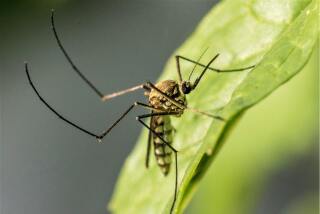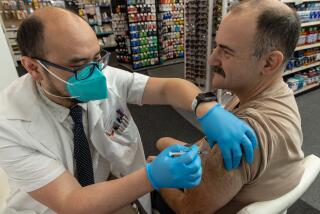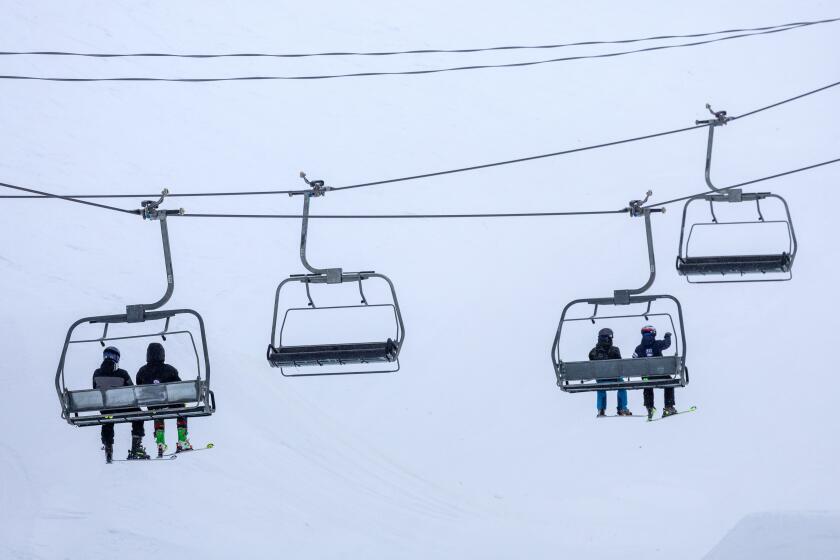Antivenin Supplies Low
- Share via
Hospitals are facing a critical shortage of the antivenin used to treat rattlesnake bites at a time when the poisonous reptiles are most likely to come in contact with people venturing outdoors.
“It’s pretty bad,” said Dr. Robert Levin, public health officer for Ventura County, where three people have been victims in the last month. “People who have been bitten by rattlesnakes may not have antivenin available to them.”
The limited supply of antivenin, which is manufactured by only two companies nationwide, was threatened when the main producer, Savage Laboratories of Melville, N.Y., had to throw away contaminated batches made in April and May, said Dr. Rick Geller, medical director for the California Poison Control System. The other manufacturer, Wyeth-Ayerst, near Philadelphia, has also experienced delays, he said.
Rich Carvotta, pharmacy director at Los Robles Regional Medical Center in Thousand Oaks, said this week that he had only four vials of antivenin in stock. A single victim needs five vials to begin treatment, and it takes a total of 12 to 20 vials to treat one victim, he said.
“If we get a bite victim today, we’ll be on the phone within minutes to see if we can borrow some from [other hospitals],” Carvotta said.
The shortage of antivenin, the preferred treatment for rattlesnake bites, comes at the time of year when more people are outdoors, and because of the dry weather rattlesnakes are looking for food and water closer to houses. Statewide, physicians have reported 129 rattlesnake bites this year, down from 142 a year ago.
Los Robles has treated seven victims since January, compared with an average of three in an entire year, Carvotta said.
Andrew Lemire, 35, of Thousand Oaks was bitten July 5 and airlifted from Westlake Village Urgent Care to UCLA Medical Center, where he was treated and released that night.
Bruce Kanegai was bitten June 26 on a Simi Valley golf course and treated at Simi Valley Hospital.
Six days earlier, Richard Green of Thousand Oaks was bitten on the hand as he attempted to remove a 4-foot snake from a neighbor’s yard. The 79-year-old retired police officer drove himself to a Kaiser facility in Thousand Oaks, but when he arrived, barely able to walk, he found the hospital didn’t have any antivenin.
An ambulance took Green to Los Robles. Incoherent and lapsing in and out of consciousness, Green was given the hospital’s entire supply of antivenin, five vials, and staff began calling other hospitals to find the additional six vials needed.
Green is still suffering pain and dizziness but said he feels lucky to have survived.
Simi Valley Hospital didn’t need to go begging when Kanegai arrived, spokesman Jeremy Brewer said. Kanegai, a 54-year-old art teacher, was bitten on his left calf while searching for a friend’s ball in the rough at Lost Canyons Golf Club. He received 19 vials of antivenin during his treatment.
Kanegai is still in constant pain and uses crutches to walk.
“I’ve been hit by a car, walked through a glass window, been hit by a boulder off a mountaintop and had my head split open by a surfboard,” Kanegai said. “After a week, I bounced back. This has been the most painful, the most crippling thing.”
Antivenin is not the only treatment for bites. Transfusions and surgery may be necessary without antivenin, according to the poison control system, but the chances of surviving are very good.
Simi Valley Hospital still had 24 vials and Ventura County Medical Center, which treats far fewer rattlesnake bites, had 10 to 12 antivenin vials in stock this week.
If hospitals share their antivenin, there will be enough to get through the year, Geller said. The California Poison Control System and the California Health Care Assn. started a program three weeks ago that allows hospitals to provide weekly updates on their antivenin inventory and receive a regional list. But only about 12% of the state’s hospitals are participating.
More to Read
Sign up for Essential California
The most important California stories and recommendations in your inbox every morning.
You may occasionally receive promotional content from the Los Angeles Times.










